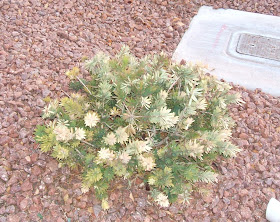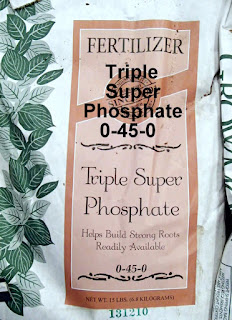Q. Nutrients and
fertilizers needed by plants are confusing to me. We have people selling “rock
dust” to handle some of these nutrients when they are missing from the soil.
How do you know which nutrients are important to plants and how much to apply?
A. There are only 16 or 17
“essential” nutrients absolutely required by plants. Some of them are needed in
large amounts and some in very small amounts. These 16 or 17 essential
nutrients have been placed into two categories; “major nutrients” (needed by
plants in large amounts) and “minor nutrients” (needed by plants in smaller
amounts).
Conventional Fertilizers
Fertilizers used by many farmers beginning mostly after
World War II, sometimes called chemical fertilizers, contain only three or four
of the “major nutrients” needed by plants. The application of chemical
fertilizers contributed to the “green revolution” in the late 1950s through the '60s. These nutrients included nitrogen, phosphorus, potassium and sulfur. When
used correctly, these fertilizers produced miraculous increases in food
production.
Problems arose when farmers began relying only on chemical fertilizers and neglecting the organics in the soil. This heavy reliance only on "chemical fertilizers" resulted in soils that were depleted of nutrients and "worn out".
Problems arose when farmers began relying only on chemical fertilizers and neglecting the organics in the soil. This heavy reliance only on "chemical fertilizers" resulted in soils that were depleted of nutrients and "worn out".
Soil Testing
Common practices before adding fertilizers included
testing the soil for nutrients (soil tests) and testing the plant for nutrients
(tissue analysis). These tests determine which fertilizers to apply and how
much of each is needed. Soil tests and tissue analysis were common, cost
effective practices for large scale producers but costly for the home gardener. The problem was that soil tests, at least for homeowners, were expensive.
Nitrogen
For small-scale producers and home gardeners, scientific
knowledge, gardening experience and observation are used to determine which
fertilizer to apply and how much. For instance, nitrogen causes growth of
leaves and stems and a dark green color. When this type of growth is slow or
needed, nitrogen might be added.
When to add nitrogen? Looking at the plant and how well it grows and how dark green was is a good indicator whether nitrogen needs to be added or not. Because nitrogen easily washes through the soil or can escape as a gas into the atmosphere (think ammonia), nitrogen is usually the one ingredient in short supply. Always. So nitrogen can be applied in small amounts, every couple months, on a regular basis through the growing season.
When to add nitrogen? Looking at the plant and how well it grows and how dark green was is a good indicator whether nitrogen needs to be added or not. Because nitrogen easily washes through the soil or can escape as a gas into the atmosphere (think ammonia), nitrogen is usually the one ingredient in short supply. Always. So nitrogen can be applied in small amounts, every couple months, on a regular basis through the growing season.
Phosphorus
Phosphorus is responsible for rooting, improved flowering
and fruiting and for a good oil content in nuts and grains. When these results are needed, phosphorus might be added. Unlike nitrogen, you can get into trouble by adding phosphorus too often.
When is phosphorus needed? Think of what it promotes; roots, flowers and fruit, and oil. So apply it when new plants go into the ground for their root development. Apply it just before plants develop flowers and fruit. And nuts develop with their high oil content.
When other nutrients are seen to be lacking because of how the plant is growing, these are added to the soil or sprayed on leaves to correct these problems. This is not a cost-effective approach for large-scale farmers however.
When is phosphorus needed? Think of what it promotes; roots, flowers and fruit, and oil. So apply it when new plants go into the ground for their root development. Apply it just before plants develop flowers and fruit. And nuts develop with their high oil content.
When other nutrients are seen to be lacking because of how the plant is growing, these are added to the soil or sprayed on leaves to correct these problems. This is not a cost-effective approach for large-scale farmers however.
Potassium
Potassium is forgotten about a lot by people because it does so much but what it does is not seen easily. Potassium deficiency is difficult to see. We do know that potassium is similar to nitrogen in some ways since it moves through the soil fairly easily and doesn't stick around like phosphorus does. We also know that potassium does not cause the same kinds of problems as phosphorus if it's over applied. We think that potassium is needed in about the same amounts as nitrogen by most plants.Apply potassium whenever you can.
When to add potassium? Not as often as nitrogen and more often than phosphorus.
Using Compost
The nutrient content, or fertilizer content, of compost depends on what was used to make it. But in a general way, most compost is pretty rich in plant nutrients.
Compost usually is fairly high in nitrogen and phosphorus. It could be a little deficient in potassium. But there is a lot of variation in the nutrients it contains in compost.Applying the correct amount of compost and mixing it into a soil can add most of the required nutrients in their proper amounts with the exception possibly of nitrogen. Nitrogen might be added to some plants to increase growth and improve its production.
Rock dust doesn't have a fertilizer analysis listed on the bag like a bag of fertilizer does. It's seldom listed on a bag of compost either but that's because compost can be extremely variable in its nutrient content. Fertilizer laws are very strict in each state. 1 a bag of fertilizers says it has something in it, it better have it or the states weights and measures police could cause some problems.Compost usually is fairly high in nitrogen and phosphorus. It could be a little deficient in potassium. But there is a lot of variation in the nutrients it contains in compost.Applying the correct amount of compost and mixing it into a soil can add most of the required nutrients in their proper amounts with the exception possibly of nitrogen. Nitrogen might be added to some plants to increase growth and improve its production.
Rock Dust
Rock dust is supposed to add plant nutrients back to the soil. This is where it can become a little bit like black magic. We know there are 16 or 17 essential nutritional elements for plants but rock dust claims a lot more than that. In some ways, it has been very fashionable to add rock dust to your garden soil and many people smile and give that addition a thumbs up.



















